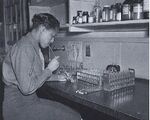Hooters Restaurant
“U can get anything you want at Hooter’s Restaurant, except for hooters.”
“Can I get a couple of breasts with that?”
“Conventional warfare is a thing of the past, and so is the conventional Army; to win wars, we need troops, and to recruits troops, we need pussy.”
Arlo Guthrie, the androgynous son (?) of folksinger Woody Guthrie, who was known for singing with an erection, opened the Hooters Restaurant eateries after the failure of Alice’s Restaurant, a chain of eateries that he opened after his song by the same title hit the Top 10 on Casey Kasem’s charts. In an environment in which clowns sell hamburgers and dildos and other toys come as a side order in children’s “Fun Meals,” Guthrie (Arlo, not Woody) decided that he needed a gimmick to go with the menu items his new restaurant chain would sell, and, he says, “I thought, What’s better than boobs?”
Marketing Problem[edit]
The problem, he learned, was how to market the idea to a fickle public who might accept the display of gigantic bare female breasts on movie screens across America and around the world under the guise of entertainment but might object to their use as a restaurant’s marketing tool. His solution was to avail himself of word play, pretending that the restaurant’s name alluded not to the slang term for women’s breasts but to owls, a colloquial name for which is “hooters.” His restaurant’s uniform--abbreviated orange hot pants and a tight white top featuring, in the chest area, an owl’s face, the wide, round eyes of which are situated above the wearer’s breasts--made clear the double meaning of the term.
Overnight Success[edit]
After the uniform was adopted, Guthrie (still Arlo, not Woody) discovered that it didn’t matter what the Hooters Girls, as the restaurant’s waitresses became known, served; patrons, mostly males and lesbians, would buy parsnips, spinach, and broccoli if they were served by a Hooters Girl.
Application Process[edit]
To become a Hooters Girl, an aspiring waitress does not have to read or write English (or any other language, or even have to speak, other than to mouth a few phrases [“Want fries with that?”, “That’s extra,” and “Lap dances come with the special of the day”]). However, they must score at least a WOW during the Hooters Restaurant application process.
Protests[edit]
Most of the public accepted Guthrie’s (yes, Arlo, not Woody) not-so-subtle allusion to, and promotion of, women’s breasts, and his restaurants were a huge, overnight success, opening everywhere, despite their limited menu of parsnips, spinach, and broccoli (originally intended to be parsley, sage, rosemary, and thyme). However, homosexual males and "transgendered persons," whatever that means, occasionally protested against the uniforms, standing outside a restaurant and holding up a sign that read “Women Are Not For Decoration,” and claiming that having breasts is “sexist,“ which prompted one of the restaurant’s waitresses to ask, “Since when?”
Lawsuits[edit]
A few transvestites, transsexuals, and other wannabe women have sued Hooters, claiming that their requirement that a waitress must be a female, rather than a shemale, constitutes sexual discrimination. However, these lawsuits have been dismissed on the grounds that to be a girl, a person must be a girl. “It doesn’t matter how much a man may want to be a woman,” Judge Judy ruled in a landmark case televised on Court TV. “To be a girl, a person must be a girl, and waitresses, especially Hooters Girls, are girls. Besides, who the hell wants to see a man in drag, wearing tight shorts and a tighter top, waiting tables?”
Hooters has also had to resort to litigation to force its restaurants on communities that the chain’s executive management considers “too bluenose” to want their business. When Troy, MI refused to transfer a lick her liquor license to a new location along Beaver Corridor, Hooters of America, Inc. sued the city on the grounds that its interest in safeguarding family values “denied” the restaurant’s waitresses their “Constitutional right to free expression” [[1]]. The city’s mayor responded to the restaurant’s charge, “The company should give a hoot and not pollute the minds of our community’s kids.”
Influence[edit]
Hooters’ success has influenced other ventures, both commercial and otherwise, in its marketing strategies. The U. S. Army instituted the Women’s Army Corp (WAC) in 1941 as a way to beef up male enlistments by offering them access to “female soldiers.” Unfortunately, as it turned out, most of the WACs (i. e., women who joined the WAC) were lesbians and wanted nothing to do with men. Consequently, in 1978, the WAC was dissolved and women were permitted to join the formerly all-male Army, causing a “noticeable swell” in the recruitment of male soldiers as more heterosexual women joined the military service.
With the general admission of female soldiers into the Army's ranks and the positive effects that their inclusion has had on the recruitment of male fighters, the Army brass has allowed greater and greater relaxation of the standards and requirements pertaining to female soldiers' uniforms. Even from the beginning, accommodations for longer hair, the wearing of jewelry items, and the minimal use of makeup were permitted. However, today, in addition to these exceptions to the regulations that apply to the daily battle-dress uniform common to all soldiers, male and female alike, female soldiers have been allowed, recently, to wear olive-drab green halter tops in lieu of shirts, camouflage bandanas around their heads instead of hats, armbands instead of shirt sleeves, and camouflage hot pants in place of long-legged trousers. Their belts incorporate bandoliers for their rifles' ammunition to give this accessory a sexier look, and women soldiers are allowed to wear high-heeled shoes with open or closed toes instead of the heavy, unattractive combat boots that their male counterparts must wear. Long, painted finger- and toenails are also acceptable. Like women in general, G. I. Jane has come a long way, baby, thanks, in part, to the inspiration of the Hooters Girls' uniforms.





